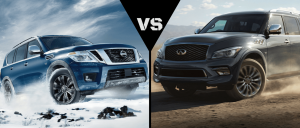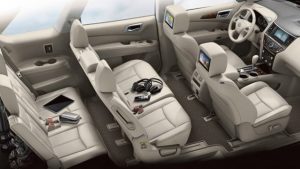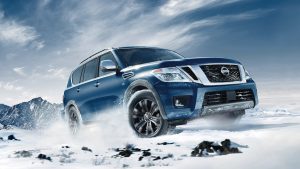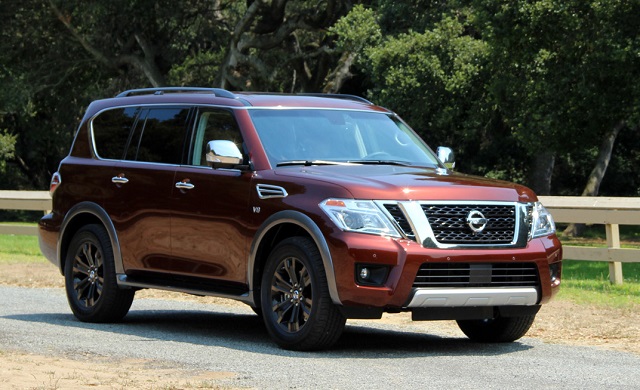Well, they all do it.
Sell lesser – and nicer – versions of their big SUVs.
For less – and more – money.
GM has the Chevy Tahoe and the GMC Yukon.
There’s the Cadillac Escalade, too.
Same basic thing, sold three different ways- each progressively fancier and (of course) more expensive.
The Tahoe, for example, shares its frame and basic layout with its pricier GMC and Cadillac-badged siblings. But it does not even offer the engine that’s available in the GMC-badged version – and which comes standard in the Cadillac-badged version.
You get, in other words, what you pay for.
But, sometimes, you get less.
Which sometimes isn’t a bad thing.
Have a look at this Nissan Armada, for instance.
It is nearly identical to the Infiniti QX80 – with which it shares pretty much everything except the Q’s stylistically questionable Guild Navigator from the ‘80s movie Dune bulbous front clip.
You get the same 5.6 liter V8 (downrated slightly on paper, but still the strongest standard V8 in the class) that powers the Q and the option to buy almost all the creature features (including a dual LCD back seat entertainment system) that are available in the Q.
The only things you can’t get are the Q’s Hydraulic Body Motion Control (HBMC) auto-adjusting suspension system and the option to buy 22 inch wheels (the Armada’s wheels max out at 20 inches).
A small price to pay – for about $20k less to start.
The Armada is the more conservatively styled (and much more attractively priced) Nissan-badged version of the full-sized, eight-passenger Infiniti QX80 SUV.
Most of the differences are cosmetic and most of those are exterior cosmetic differences. The Armada’s interior layout is virtually identical to the Qs, which is either good for Nissan or bad for Infiniti – depending on your point of view.
Bothfeature three row seating, body-on-frame construction, the ability to pull an 8,000-plus pound trailer and are available with truck-type (heavy duty) 4WD with a two-speed transfer case and Low range gearing.
The Armada is however bigger – and brawnier than – competing models like the Chevy Tahoe and Ford Expedition, which are physically smaller vehicles and also have smaller engines (and in the case of the Ford, fewer cylinders).
It’s also a much better deal: $45,600 to start for the base 2WD SV trim – with the standard 5.6 liter V8 – vs.$47,450 for the least expensive version of the 2018 Tahoe and a stunning $51,695 for the least expensive version of the 2018 Expedition – which no longer even offers a V8 engine.
A top-of-the-line Platinum trim with the 5.6 liter V8 and 4WD stickers for $61,590 – vs. $78,545 for a top-of-the-line MAX Platinum Expedition with a turbocharged 3.5 liter V6.
Prices for the 2018 QX80 hadn’t been released when this review was written in mid-October 2017, but the 2017 QX80 starts at $63,850.
You might also want to cross-shop the Toyota Sequoia – which starts at $48,300 and also comes standard with a large (5.7 liter) V8. It’s an old design – the current model dates back to 2008 – but that can be a good thing in terms of proven design and a less-complicated design.
WHAT’S NEW
After last year’s complete redesign – including a stronger standard engine and a much roomier (class-roomiest) backseat – the 2018 Armada receives a few minor tweaks, including an updated app suite (Hands-Free Text Messaging Assist, Enhanced Voice Recognition) piped through an updated 8-inch LCD touchscreen, which s standard in all trims.
Platinum and Reserve trims also get a standard Intelligent RearView Mirror, which pipes a hi-res image of what’s behind you into the rearview mirror.
More standard engine and horsepower – and amenities, including a standard 13-speaker Bose stereo rig – than Tahoe or Expedition offer.
At a lower price.
Basically the same thing as an Infiniti QX80, at a much lower price.
Arguably a nicer-looker than the odd-looking Q.
Roomier second row than Tahoe or Expedition.
WHAT’S NOT SO GOOD
Tow rating no longer best in class (previous-generation Armada was rated to pull 9,000 lbs., this one maxes out at 8,500). A Tahoe can pull 8,500 lbs. and the 2018 Ford Expedition has the current best-in-class max tow rating of 9,200 lbs.
It’s a behemoth – almost half a foot longer overall than a Tahoe.
Widest turning circle (20.6 feet) of the bunch.
Not as much cargo room as Expedition (and much less cargo room than long-wheelbase Expedition EL).
What you’ll find here is the same thing you’ll find under the hood of the QX80: An updated (direct injected, higher compression) version of Nissan’s 5.6 liter V8 engine.
In the higher-priced Q, the V8 supposedly makes more power: 400 hp and 413 ft.-lbs. of torque vs. 390 horsepower and 394 ft.-lbs. of torque in the Armada. But a look through the technical specifications comes up dry as far as any reason for the difference in rated output. The engines are mechanically identical and built on the same line in Tennessee. It is almost certainly the case that the QX’s rating is higher because its price is higher.
Regardless, it’s the strongest engine in this class.
The Chevy Tahoe’s 5.3 liter V8 makes 355 hp and 383 ft.-lbs. of torque.
The Expedition doesn’t even offer a V8 anymore.
It is powered by a twin-turbo 3.5 liter “EcoBoost” V6 that makes 375 hp (and, to give it its due, a very impressive 470 ft.-lbs. of torque). Hence the Expedition’s class-highest max tow rating.
However, there have been customer complaints about the real-world performance (and pulling power) of Ford’s twin-turbo V6 engine. And regardless, it is an inherently more complicated engine, with potentially very expensive components (two turbochargers and all the peripherals) that you won’t ever have to worry about with a simpler, inherently less maintenance-intense V8.
Ford’s decision to back away from V8s in favor of smaller (and tubocharged) sixes even in big SUVs like the Expedition was based on fuel efficiency considerations, but the Expedition’s EPA numbers – 15 city, 22 highway for the 2WD version and 15 city, 20 highway with 4WD – are not spectacularly better than the Nissan’s (14 city, 19 highway with RWD, 13 city, 18 highway with 4WD) and are actually slightly worse than the V8-powered Chevy’s (16 city, 23 highway for the 2WD version and 16 city, 22 highway for the 4WD version).
In real-world/mixed use driving, all these buses will typically average in the mid-high teens.
Which sounds awful but isn’t when you take a look at the mileage stats posted by large, three-row crossovers (like the Mazda CX9, reviewed here) that have much smaller engines and far less capability. These average low 20s.
Which is awful given what they can’t do vs. what a big SUV can do.
Like pull an 8,500 lb. trailer, for instance. That’s the Nissan’s rated maximum capability.
The Ford annd Chevy can pull more but it’s worth a mention that the Nissan’s max tow rating is the same for both 2WD and 4WD models. The Tahoe’s max tow rating (8,600 lbs.) is only with 2WD; the 4WD version’s rating slips to 8,400 lbs. – 100 lbs. less than the 2WD or 4WD Armada’s.
The Ford’s max tow rating (9,200 lbs.) is the same whether you choose 2WD or 4WD, but goes down slightly to 9,100 lbs. if you choose the long-wheelbase EL version.
It’s still king of the hill when it comes to pulling, though. 
Behind the brawny 5.6 liter V8 is a seven-speed automatic (the Ford gets a ten-speed for 2018) with racy rev-matching downshifts similar to what you’d get in Nissan’s 370Z sports car. This is an unusual – and unusually cool – thing to find in a burly SUV.
There are also driver-selectable Snow and Tow modes for the transmission, which when engaged alter shift points to suit those conditions. The optional All-Mode 4WD system is fully electronic, with driver-selectable Auto, 4H and 4LO modes. The two-speed transfer case has a 2.70:1 ratio when 4LO is engaged.
One downside – if you like power-brake burnouts – is that you can’t do them in 4WD models because the 4WD is basically always on. There is no 2H (2WD) setting. In Auto, the system will automatically send power to the front wheels (as much as 50 percent) if the rear wheels are slipping.
So you can’t get the rear wheels to slip.
Much less spin.
On the upside, you don’t really have to think much about when to engage the 4WD. Unless the going gets really rough, Auto will cover you when you run across the occasional slick spot – and will just as automatically revert to 2WD (RWD) when the road is dry and traction is good, reducing wear and tear on the system and using a bit less fuel, too.
Speaking of which: Though the updated 5.6 V8 is a very high compression engine (11.2:1 vs. 9.8:1 previously) it is designed to run on regular unleaded. This is one of the few perks of direct (vs. port fuel) injection. A non-perk is that DI engines are prone to carbon fouling over time. But the industry is going this way because DI provides a slight fuel economy benefit and even fractional gains are a Big Deal in terms of complying with the federal government’s fatwas. (More about that here.)
The V8 also features variable valve timing and lift, which basically ramps up the aggressiveness of the valvetrain’s geometry to let the engine make more power when needed, but dials it back down otherwise, to maintain reasonable fuel efficiency and smooth operation.
It may not let you do a burnout, but this thing’s a ripper.
Zero to 60 in about 6.3 seconds, which beats the twin-turbo’d Ford (6.5 seconds for the 2WD version) and blows the V8 Chevy (7.1 seconds for the 2WD version) into the weeds.
For a 5,600 pounder (and that’s the 2WD version) this is spectacular, almost walk-on-water performance. The Tahoe is nearly 300 pounds lighter (5,356 lbs for the 2WD version) and it’s still a full second slower.
To go faster than the Nissan, you’ll need to go up in price – to something like the GMC Yukon Denali, which comes with a 420 hp 6.2 liter V8.
It also comes with a $65k-plus base price.
The Ford is the only other SUV in the Armada’s price ballpark that almost matches its straight-line heroics – but you pay more up front and about the same at the pump and will have to take a leap of faith about the long-term prospects of that twin-turbo six.
The Armada doesn’t offer the Q’s Hydraulic Body Motion Control suspension – which tamps down body roll when cornering hard by stiffening up the shock valving on the inner front and rear wheels during high-load cornering, to compensate for weight shift – but you have to be really cornering hard for this to be a noticeable benefit.
What’s more everyday noticeable is the big Q (er, Armada’s) physical proportions.
It’s about half a foot longer overall than a Tahoe and its turning circle is about a foot wider (20.6 feet vs. 19.5 for the Chevy; 20.4 for the regular wheelbase version of the Ford) and that makes it a bit more awkward to park, especially given that most parking spots are sized to fit much smaller cars.
These full-sized ‘utes are also very wide: 79.9 inches for the Armada (for a sense of scale, a mid-sized sedan like the Toyota Camry is 71.7 inches wide) and that adds to the Squeeze Factor, as far as slotting into parking spots designed for Camry-sized cars and having enough room on either side to open the doors wide enough to get in and out not-awkwardly (and without dinging someone else’s door). 
The Armada also sits higher off the ground than others in this class: 9.1 inches vs. 8.3 for the Ford Expedition and (surprisingly) just 7.9 inches for the Chevy Tahoe (this is less clearance than many light-duty/car-based crossovers have; that Mazda CX-9, for instance). There are grab rails built into the A pillars on the driver’s and front seat passenger’s side to aid with climbing on board. Also running boards along the side.
The Armada’s generous ground clearance doesn’t mean rolly polly handling (see above) and will be a help as far as dealing with winter weather, even if you don’t buy the 4WD version.
All the vehicles in this class have full perimeter steel frames that the body bolts onto – with rubber biscuits in between. Light duty crossovers typically have welded-together bodies and frames (i.e., unibody construction). Body-on-frame construction (with those rubber biscuits in between) is heavier – not so good for gas mileage – but nothing tamps down pothole reverbs better. The Armada, though, is particularly posh, probably because its an Infiniti in drag while the Tahoe is a de-contented GMC (as the Expedition is a less-than-Lincoln).
Quiet, too – in part because it has high-end acoustic-tempered side glass and windshield. It also gets the same insulation as the QX… because it is a QX.
If money weren’t an issue, most people would probably go for the Yukon over the Tahoe – and a Navigator over an Expedition.
You get more stuff. Nicer stuff.
With the Armada, you pretty much get the same stuff – for a lot less money.
And you don’t get the Q’s face.
Those weird low-mounted headlights, that protruding forehead. It really does look like a Guild Navigator from Dune.
Basic handsome truck face here. Very similar to the mug of the Titan pick-up.
Inside, though, it is virtually identical to the Q – and that’s a good thing.
Same wraparound/bathtub dash shape and instruments (minor differences in backgrounds/fonts). The identical center stack and center console and controls, including the rotary knob controller behind the shifter for the 4WD system. You get different leather and wood trim plates, but neither looks less nice.
The top-of-the-line Platinum trim gets second row seat heaters, a heated steering wheel and the same dual-LCD entertainment system (with wireless headphones) you’d find in the Q.
But at a discount of about $6k vs. the price of the base QX80.
And the base SV Armada comes with more (such as that standard 13 speaker Bose stereo rig and the 390 hp V8) for much less than its Tahoe and Expedition rivals.
You also get a larger (8 inch) main LCD touchscreen than in Expedition, which comes standard with a puny 4.2 inch screen (and a gauge cluster that’s generically similar to lesser Fords).
The Expedition, however is available (uniquely, in this class/price range) in a long wheelbase version which you could almost move into: 42.6 cubic feet behind the third row (vs. 16.5 for the Armada and 15.3 cubic feet for the Tahoe) and 130.8 total with the second and third rows folded (vs. 95.4 in the Armada and 94.7 in the Tahoe).
Put a mattress back there, a mini-fridge . . . and cue your inner Chris Farley.
THE REST
In some ways, the Armada is more like a high-riding (and really huge) luxury sport sedan than a truck-based SUV. Not in terms of design, but of look and feel. The Tahoe, for instance, has a “trucky” column shifter and a main gauge cluster very similar to a Silverado 1500s. The Ford is likewise F-150-esque on the inside (though it also has a console-mounted gear selector, like the Nissan).
The only gripe I’ve got is the absence of a transmission temperature gauge (important, if you’re going to tow) and the lowered max tow rating – which is odd given the ’18 Armada’s not only got more engine than the previous-gen Armadal, it also has a beefier frame.
It ought to be able to pull more than the Tahoe, especially.
But otherwise?
THE BOTTOM LINE
Imagine being able to buy a Yukon Denali for a Tahoe price.
That’s basically what you’re looking at here, Nissan-Infiniti-wise.
And in a nicer looking wrapper, too.
…
Got a question about cars – or anything else? Click on the “ask Eric” link and send ’em in!
If you like what you’ve found here, please consider supporting EPautos.
We depend on you to keep the wheels turning!
Our donate button is here.
If you prefer not to use PayPal, our mailing address is:
EPautos
721 Hummingbird Lane SE
Copper Hill, VA 24079
PS: EPautos stickers are free to those who send in $20 or more to support the site. Also, the eBook – free! – is available. Click here. Just enter you email in the box on the top of the main page and we’ll email you a copy instantly!



















Unfortunately uncle scam claimed the life of the Xterra line as it wasn’t renewed with the shift to the more round Renault style bodies that Infiniti has and for fuel standards. Wife and I were interested in getting the new Pathfinder till we saw it up close and test drove it. Basically a weak minivan with no SUV characteristics. Baby seat doesn’t fit well in the Xterra but that is our only complaint with the vehicle. Driving on its 6th year and 120,000th mile with zero electrical or mechanical issues. I want to get some short tube headers installed but wife is concerned it will wake junior from his car ride naps. The small circle cult following of the Xterra is strong enough that I could have availability of replacement parts for another 10 years if I wanted. Basic S Model with no frills as most of the import auto makers didn’t jump on the GPS tracking and LCD screen fad as the government motors group.
Hi Brazo,
I own an ’02 Frontier – the basis for the Xterra – and it’s a great little truck. I strongly recommend these (built through 2004) to anyone interested in a solid, fairly simple pick-up. The Xterra gets a thumbs up from me for the same reasons, with one caveat: The V6 can be a pain to wrench on due to space considerations in the engine compartment.
One bad thing about the new Armada (i’ve browsed and tested them) is the 3rd row seat has buttons on each side near the cup holders that fold the seats up and down…. with no parental override or shut off. I questioned the Nissan dealer salesman about this and his face went blank when I showed that it could easily crush a kid if they tried. No safety stop when it meets resistance. Whats going to stop over-juiced junior from playing with it and threatening to crush their younger siblings from the 2nd row? Why would you put these buttons IN the 3rd row that folds and not behind it?
Hi Brazos,
Hat tip for that sir! I hadn’t noticed… and you’re right, it’s a definite issue. One that may end up biting them on the buttocks, too.
Unfortunately, these overpriced behemoths have become our only options for true, body-on-frame SUVs with V8s. The midsize SUV segment is close to being non-existent. The 4Runner is the only one left, and Toyota swiped the V8 option from it years ago.
I wisely bought an Explorer before it transitioned into to an expensive, tech-laden crossover.
Hi Handler,
You’re right – and it’s lamentable.
I also lament the disappearance of compact-sized pick-ups, especially with four cylinder engines and 4WD, like the ’98 Frontier I used to own.
Now, the choice is a mid-sized truck – and you have to buy a V6 to get 4WD.
OT this article. Apologies all.
artwork for MeinDampf project
I’m so gay for chev row lay!!!
Air Rick Peters Mein Dampf
https://i.imgflip.com/1y1oig.jpg
It was probably a good thing Ford let the Ranger rot on the vine the way it did. The Ranger ended up being the only pick-up on the market that wasn’t an absurdity. It became the only pick-up where you could load stuff in the bed easily without needing a damn step ladder. Even the new “midsize” trucks have these idiotic tall beds. I wouldn’t be surprised if the “reasoning” behind them was for saaaaaaaaaaaaaafety.
Without a doubt the most damaging intervention by Uncle, has been the Nuclear Scare Scam.
The whole Hiroshima Psyop is a big pile of steaming bullshit.
Everyone should look into this, it might be something Trump would be willing to move on, if enough groundswell can generated.
The Nuclear Scare Scam | Galen Winsor
https://www.youtube.com/watch?v=ejCQrOTE-XA
My first reaction was that if someone needs to buy such a BIG SUV, they should just get the long wheelbase version of the Ford or Chevvy products. The extra inches mean they could haul many things that just won’t fit inside the Armada.
Of course, the other side of the coin is that just a few extra inches can make a Big SUV much harder to park, or maneuver in tight areas.
It’s a trade off that each buyer needs to decide for themselves.
But if the decision simply came down to which is more fun to drive, I’m pretty I’d go with the Nissan.
And I’d go with the Suburban. Frame wise, no comparison. Down hole grunt, same thing. They’d have to give me the Armada. Back in the day when the rear was straight as in the same width and height as the front I’d stick two pallets of feed or seed in a Suburban and shut the doors and haul ass. Well, that’s a done deal now with their bs of mimicking a Dodge station wagon from 10 years ago. Why does this shit go on so long? It reminds me of the slab sided fender Audi came out with a couple decades ago and then everybody had to follow that style for a decade and it got old fast. So it goes with SUV’s and that thinning the vehicle out as it goes back and gets narrower and narrower. I remember when an SUV was made for something besides…..whatever it is they’re mimicking. They’re just all stupidly designed now and not nearly as useful as before. I still have a Chevy pickup with a galvanized bed and probably will outlive me. So, why no galvanized beds? Who wants one that long being the throwaway bs they now are? Besides, nobody even thinks of keeping one long enough to need a galvanized bed. Well, some people do, the people who really need a pickup but they’re fast becoming the minority. My wife worked with women who bought pickups “so they could see…..cause they couldn’t see in their cars”. What ever it was they needed to see. I think I’m stuck in the early 90’s. That POS Z 71 I have is junk as is the Ford and Dodge to match. 2000 was the point of no return for light trucks. One side, some, heavy duty, the other side, none, heavy duty. And the horse they rode in on………..
Hi Mike,
That’s it, exactly.
These are all really big vehicles – and even a few more inches can mean the difference between manageable and not. The ‘Burban is a bus. Even out here in The Woods, that thing would be a lot to deal with.
And in suburbia.. well, the parking spots have been downsized to accept Prius-sized cars. Dealing with a full-sized SUV in a city or suburban area is… a challenge!
I’d love to drive something truly big, but only out in the boonies at least to start.
https://municibid.com/Listing/Details/5113613/1990-Ford-F800-Dump-Truck
I remember driving an F800 dump truck when I had to deal with trees and stuff on some properties that had big yards. Towed a big chipper behind too.
http://r3.greenindustrypros.com/files/base/image/GIP/2010/02/16×9/1280×720/1712woodchipper_10157809.jpg
God I was an awful driver with that thing. I just didn’t really care, backing up was impossible, so why not just get it over with. I’m a machinesadist I guess, sorry machines.
That’s another service business idea. Why not be available over skype or in person to educate someone about driving large vehicles. And things of that nature.
Hell you could make money showing Generation Z kids how to drive a nail. Most of them could watch a YouTube video on it and still not get it right, I’d bet.
There’s good money in being the one in a million hands on Morlock in a world increasing full of nothing but pushing and screen swiping Elois.
Hi Tor,
I live in the country, actually have need of a truck. So I have one. But it’s a small one. A compact Nissan Frontier. There are times when a full-size truck would be handy, but 95 percent of the time, my compact-sized truck is sufficient. So I bought the truck that meets my needs 95 percent of the time.
My Nissan is only slightly larger than my ’76 Trans-Am and only in terms of its length.
But it hauls logs, 4×8 sheets, stuff I need to take to the dump.
And it doesn’t hog my driveway or garage.
Not slamming what other people need or want. Just saying that – for me – super-sized is way more than I want to deal with.
I turned over the kit and kaboodle at the place I lived at 2 place before my Houston place. Gone are my glory days, when I had a place to keep all the vehicles in whatever condition I cared to.
Best truck as far as cost/benefit I ever had was a shit brown 85 Nissan.
http://barnfinds.com/rust-free-work-ready-1985-nissan-pickup/
I liked her so much I even swapped fluids with her and gave her new brake maxipads and stuff. I’m kind of abusively Muslim when it comes to maintaing my 4 wheeled ladies now that I think about it. Sorry 4 wheeled ladies.
Sweet Brown Sugartits Truck https://www.youtube.com/watch?v=WBR20t8v6sE saved me when I was getting chased by some hoodrats for who knows why, I guess I was offending them for carrying appliances in the bed and having gainful employment of my time or something.
Correction: The current Nissan Armada is not based on the latest Nissan Titan (or Titan XD) platform. The Current Titan platform was designed in California and engineered in Michigan (and made in Mississippi). It was a rush job after the 2008 deal with Chrysler fell through to make the new Titan a rebadged Ram pickup. The XD platform is shared with the Nissan NV full size van line. On the other hand, the current Armada and the QX80 are both designed on the older Nissan Patrol platform, the Y62 platform, which came out elsewhere in the world in 2010. Thus it’s now a 7 year old design. It is build in Japan. Similarities in external appearances are merely cosmetic.
This is important on a number of levels. First, the Nissan Patrol is a worldwide proven platform akin to the Toyota Land Cruiser. It’s not quite as reliable as the Toyota, but it’s less expensive and quite capable. This also means the chassis and suspension are proven reliable technology that has been tested in real world conditions from Australia to Abu Dhabi. The main difference is the engine and the lack of locking differentials that are available in overseas markets. The US Armada will make do with electronically managed torque transfers, mostly by selective application of the brakes and using sensors to detect wheelspin. It should be quite capable and likely better than the Ford and GM equivalents, even if those are part-time 4WD vehicles and the Armada is full-time AWD.
The Titan platform is new and unproven. Nissan reliability has suffered in recent years, dropping to below that of most American makes (I tend to blame Renault, the parent company, but have no proof of this). However, the Patrol is their flagship product outside of the US and is likely to be pretty reliable. My guess is that this will do better than the Ford/GM competition in terms of reliability and durability while not quite as good, but tens of thousands of dollars less expensive than, the Toyota Land Cruiser, which starts at just over $80k and basically has no options, last I checked. It’s also larger and roomier inside than the Cruiser, especially the third row and behind the third row.
In all honesty, this is probably Nissan’s best production vehicle sold in the US right now, at least for the masses. The GT-R is amazing, but isn’t accessible to the masses. Nothing else they make is competitive, much less superior, in its class, even in the Infiniti line. Most are also-rans. The Murano is at least distinctive and a good value. But I can’t think of a good reason to go with Ford/GM over the Armada given its price and capabilities. Perhaps styling, but I think the Armada is a nice looking truck, and a throwback to when SUVs were trucks, not wannabe minivans.
Nice assessment of the Armada and informative info on Nissan. I used to hate vehicles like this, but since buying my first SUV (a 2005 Acura MDX), I appreciate heavy vehicles, responsive engines and don’t really give too much a crap about gas (right now). I like towing capability and have yet to tow anything, but I will be in short order.